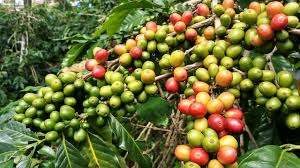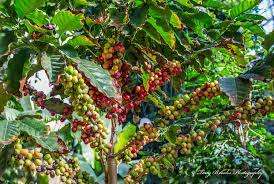The History of coffee beans is very interesting. I went to the Netherlands for a training job. Young age then and that first trip abroad. A country so organized. He liked many things in the country, including flowers. And I liked their coffee. I used to work in an exploration association. Every day when I passed in front of their coffee bar, the intoxicating smell of coffee was very attractive.
I used to sit with a cup of coffee during breaks. The taste and aroma of coffee made from filter roasted beans are amazing, which is not available in homemade instant coffee. I believe many others like me are attracted by the intoxicating aroma of coffee. Coffee is the desired soft drink of many young and old people around the world.
The first roasted coffee beans

The first roasted coffee beans in the world came from Arab scholars. This is known from written documents. It is also known in their writings that it was a very dear thing to them; Because the caffeine in coffee helped prolong their working hours. The coffee drink was first made from roasted beans in Yemen.
Later it spread to the Turks and then gradually spread to the whole world. Other experts believe that the coffee plant was brought from Abyssinia to Yemen and based on the Yemeni tradition, the coffee plant and the Katha Edulis plant were planted together there. Coffee is a very important and widely traded commodity in the world which is imported and exported to different countries of the world; Such as Central and South America, the Caribbean, and Africa. The coffee plant is native to the highlands of Yemen and the highlands of southwestern Ethiopia. Coffea Arabica is now rare in Ethiopia. From their original habitat, they have spread to Africa, Latin America, Southeast Asia, China, and various islands in the Caribbean and Pacific.
The world’s most cultivated coffee
The world’s most cultivated coffee was first described by the French naturalist Antoine de Juss. He first named it Jasminum Arabicum. Then a lot of research was done on this specimen in the Botanical Garden of Amsterdam and Carl Linnaeus placed it in the new genus Coffea in 1737 and named it Coffea arabica. This coffee tree belongs to the Rubiaceae family.
Coffea Arabica

Coffea Arabica is also called Arabian Coffee Mountain Coffee or Arabica Coffee. It is believed to be the first species of coffee to be widely cultivated throughout the world. 60 percent of the world’s coffee is made from this species. Coffea arabica is the only polyploid species in the genus Coffea. A normal coffee plant has 2 sets i.e. 22 chromosomes. Coffea Arabica has 4 sets of chromosomes i.e. 44 chromosomes in total. Coffea Arabica is a hybrid plant. Hybrid Coffea arabica plants are obtained by crossing two diploid coffee plants, Coffea canephora, and Coffea Eugenioides.
Coffea Arabica is an evergreen and perennial plant. Within two to four years of planting, the coffee plant produces small white, strongly scented flowers. Their sweet scent is similar to the scent of bell flowers. A flower that blooms on a sunny day produces more coffee beans. If there are too many coffee beans together on the plant, there is a risk of bean quality getting worse. That is why the tree is pruned regularly to avoid excessive flowering. Flowering is short-lived, lasting only a few days. Then the berries or fruits start to form. Fruits are dark green-like leaves.
When they develop, they first turn unheroic and also light red. It then gradually turns dark red in color and becomes shiny. At this time, this fruit looks like a cherry fruit, so they are also called cherry. If you can collect coffee berries at this time, you can get high-quality coffee.
Coffee trees can be 9 to 12 meters in height

Coffee trees can be 9 to 12 meters in height. There are many branches. Leaves are ovate to ovate. 6-12 cm long and 4-8 cm wide. Glossy dark green leaves. The berries are egg-shaped and over 1 cm long. Picking or collecting berries too early or too late reduces the quality of the coffee. They do not ripen together.
Sometimes the farmer shakes the tree to facilitate the work and both unripe and ripe berries fall to the ground and both unripe and unripe berries are collected. As a result, the quality of the coffee is not good. Each coffee plant can produce 0.5 to 5.0 kg of dry coffee beans. It depends on the variety of coffee and the climate and season.
Each berry has two locules, or chambers, that contain the coffee beans. Usually, there are two beans in a berry. But it can be seen to change. Some berries have three pods, while some contain only one pod. These sap or seeds are covered with two membranes. The external shell is called diploma fleece and the inner subcaste is called gray skin.
Coffee tree takes seven years to fully mature

A coffee tree takes seven years to fully mature. This tree can grow well with 40 to 59 inches of rainfall, which is consistent throughout the year. Coffee trees are generally cultivated at altitudes between 1,300 and 1,500 meters. The tree can grow up to a maximum altitude of 2,800 meters, But there are also examples of growing coffee trees at sea level.
Coffee plants can grow in low temperatures, but never in ice. They grow best at an average temperature of 15 to 24 degrees Celsius. Commercially cultivated coffee trees grow up to 5 meters tall. They are regularly cut or trimmed to a height of 2 meters to facilitate the collection of coffee fruits. This plant can grow well in light shade.
If these plants are planted in acidic soil and low temperature, there is a risk of damage. This species is more vulnerable to insect attack than Coffee robusta. On the island of Java, coffee grows all year round



I have been absent for some time, but now I remember why I used to love this blog. Thanks , I will try and check back more frequently. How frequently you update your site?